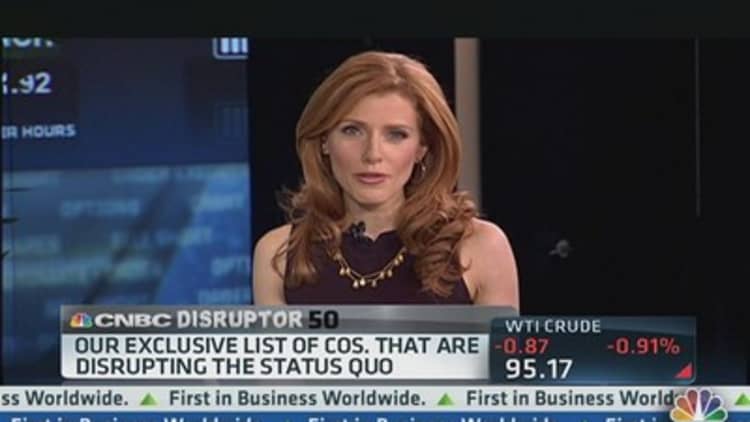The media industry is under attack. There isn't a silo within media where an incumbent is safe from the power of disruptors to rapidly and thoroughly upend the established order.
In some industries, disruption tends to take its time—think health care, financial services or education—stodgy legacy businesses of the 20th century where incumbents can hold out for a good, long while, even if time is no longer squarely on their side.
In other industries, the disruption tends to reflect a few key trends that have exploded among the younger generations of Americans—think the collaborative, social sharing economies behind an Etsy or Pinterest.
(Read More: The Fashionistas of Disruption)
In media, it's a veritable onslaught of disruption, many variations on the disruptive model being used to get the job done and send the old guard into decline, as evidenced in CNBC's inaugural Disruptor50 list.

An antenna smaller than your fingertip has the major television broadcasters including News Corp., Disney and Comcast crying foul in the courtroom.
An evolutionary blogging tool now averaging 70 million posts a day may soon overtake McDonald's in the "billions served" category. At least, that's what Yahoo! must think after paying $1.1 billion to acquire Tumblr in the week after we named it to this Disruptor list.
Even the most legendary of disruptors is now spotted as being vulnerable to a major challenge: Sean Parker predicts that iTunes will soon be the No. 2 music service in the world. There is no doubt iTunes hold over the music market--and the battle to consign the mindset of the music owner to history with the rise of music subscription services--is just heating up. While one of our Disruptors could one day rival Apple in terms of revenue generated for the music industry, Google also just announced its entry to the music service market this month.
If the disruptions in media don't tie up into a neat package with one transformative ribbon wrapped around them as well as a buzzword to trumpet that reaches to the heart of the Gen Y audience, media's existential crisis does key in on a few core vulnerabilities: it's less product than fickle subscribers frustrated by a price-fixed industry, less service than legacy advertising revenue others are aiming to steal away.
(Read More: Introducing the CNBC Disruptor 50)
The media elite—from the publishers to the broadcast operators—are increasingly aware that advertisers and subscribers have become fertile ground for disruptors to plow.
The 10 largest movie studios now all advertise on Tumblr. Twitter is poised to hit $1 billion in revenue next year, and 60 percent of its revenue may come from mobile within two years.
It's impossible to talk about disruption in any sector without at least touching on the outsize role of social.
(Read More: Upstarts Taking Tech Disruption to the Cloud)
A news site's socially shared, viral content has quickly become a plague for traditional print and online publishers. You won't see it among the Pulitzer Prize winners (at least not yet), but you are probably among those who have watched the now-ubiquitous cute kitten videos and even cuter cinematic masterpiece, "The Angriest Babies in The Whole World."
Admit it. You and your partners in viral video crime have watched enough hours of these high points in low culture to equal 300 years, according to this enfant terrible of media's count.
Aereo has packaged the major networks into a dollar a day or $80 a year package that can be DVR'd at your leisure over the Internet.
Spotify already has 6 million paying subscribers and could soon be generating more music industry revenue than iTunes.
Tumblr CEO David Karp remarked, "Disruption is democratizing what was once wholly owned by influencers at big institutions."
(Read More: What Dooms Innovation to the Graveyard?)
That ownership has long included the attention span of the average American and the ad dollars of the major corporations, but it's an endangered ownership model. The legacy influencers suddenly find themselves being influenced by the disruptive upstarts.




